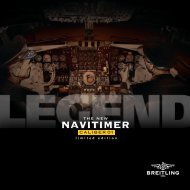Master Compressor Extreme LAB 2 Tribute to Geophysic. Jaeger ...
Master Compressor Extreme LAB 2 Tribute to Geophysic. Jaeger ...
Master Compressor Extreme LAB 2 Tribute to Geophysic. Jaeger ...
Create successful ePaper yourself
Turn your PDF publications into a flip-book with our unique Google optimized e-Paper software.
When in 1958 <strong>Jaeger</strong>-LeCoultre launched the Chronomètre <strong>Geophysic</strong>, the mother of allrugged sports watches from the Grande Maison, the quest was opened on how <strong>to</strong> design awatch that would suit the demands of scientists and engineers, who long for a timepiece withoutstanding precision and performance even in the worst surroundings. <strong>Jaeger</strong>-LeCoultreanswered with the creation of the Chronomètre <strong>Geophysic</strong>, a wristwatch that withs<strong>to</strong>odmagnetic fields up <strong>to</strong> 600 gauss – at that time an extraordinary quantity – as well as anoutstanding shock resistance system.However, this was only the beginning. In 2002, <strong>Jaeger</strong>-LeCoultre <strong>to</strong>ok up the idea of sportswatches in a new line called <strong>Master</strong> <strong>Compressor</strong>, in which it chases the pinnacle of ruggedwatches with up-<strong>to</strong>-date technical innovations: In 2002 the <strong>Master</strong> <strong>Compressor</strong> withcompression keys for easy and secure locking system of the crown was launched; in 2005followed the <strong>Master</strong> <strong>Compressor</strong> <strong>Extreme</strong> with inventive shock-absorber system; 2007 <strong>Jaeger</strong>-LeCoultre reopened the field of diver’s watches with a mechanical depth gauge in the <strong>Master</strong><strong>Compressor</strong> Diving; 2007 they revealed their state of the art in mechanical watchmaking withthe lubrication-free movement of the <strong>Master</strong> <strong>Compressor</strong> <strong>Extreme</strong> <strong>LAB</strong>, a movement housedin a specially designed, shock-resistant case – the first ever watch <strong>to</strong> eliminate the problems oftemperature-sensitivity of watchmaking-oils. And therefore another giant step <strong>to</strong>wards theperfection of timekeeping.Some of those watches have accomplished exceptional achievements in extreme conditions.The <strong>Master</strong> <strong>Compressor</strong> Diving GMT for example went down <strong>to</strong> a depth of 1,080 meters offthe coast of Hawaii, pinned <strong>to</strong> a submarine <strong>to</strong> prove its sturdiness in a place where no diver cango.The <strong>Geophysic</strong> Expedition <strong>to</strong> the HimalayasIn the spirit of this watchmaking past, <strong>Jaeger</strong>-LeCoultre, even before the launch of the new<strong>Master</strong> <strong>Compressor</strong> <strong>Extreme</strong> <strong>LAB</strong> 2 <strong>Tribute</strong> <strong>to</strong> <strong>Geophysic</strong>, proves the watch’s sturdiness bysending it <strong>to</strong> the great outdoors, celebrating the spirit of its ances<strong>to</strong>r and the extraordinaryfunctionality of its <strong>Master</strong> <strong>Compressor</strong> <strong>Extreme</strong> Line.In the autumn of 2009, as a tribute <strong>to</strong> <strong>Geophysic</strong>, <strong>Jaeger</strong>-LeCoultre outfitted the “An<strong>to</strong>ineLeCoultre Expedition” consisting of three exceptional mountaineers, set out <strong>to</strong> conquer a virginsummit in the Himalaya. The <strong>Master</strong> <strong>Compressor</strong> <strong>Extreme</strong> <strong>LAB</strong> 2 <strong>Tribute</strong> <strong>to</strong> <strong>Geophysic</strong> wasone of the three timepieces that guided the alpinists <strong>to</strong> the summit. The team consists ofrenowned Swiss climber Stephané Schaeffer and the Pakistani Sherpa Little Karim and theNepalese world famous Apa Sherpa, who tackled the Mount Everest 19 times. They set out <strong>to</strong>climb a technically highly demanding 6589 meters peak in the backyard of Mount Everest. Aftera grueling climb – at the base camp already they had <strong>to</strong> force themselves through over 40Centimeters of newly fallen snow – and under constant thread of avalanches, they reached thepeak on the 22 nd November 2009. To honor his<strong>to</strong>ry and high horology, they then christenedthe Mountain “An<strong>to</strong>ine LeCoultre’s Peak”.For the climbers, who rely on the precision of a 1958 Chronomètre <strong>Geophysic</strong> watch as well asa <strong>Master</strong> <strong>Compressor</strong> <strong>Extreme</strong> <strong>LAB</strong> and the new <strong>Master</strong> <strong>Compressor</strong> <strong>Extreme</strong> <strong>LAB</strong> 2 <strong>Tribute</strong><strong>to</strong> <strong>Geophysic</strong>, the aim is not only <strong>to</strong> reach the summit, but <strong>to</strong> do so in the adventurous way oftraditional “fair means” – classical mountaineering style. This concept of course fits neatly in<strong>to</strong>






